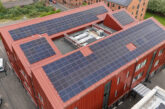
Oliver Johnson, ABB’s Business Development Manager for Electric Vehicle (EV) Charging, outlines the key technical items that electricians need to know about EV charging.
How does EV charging work?
Basically, there are two types of EV charging technology: AC (alternating current) and DC (direct current).
The batteries themselves need DC power to charge them, and because the grid supplies AC power, it has to be converted from AC to DC somehow.
AC chargers rely on a battery charge inside the car body to convert AC to DC. They are the most common type of EV charger in the UK today, particularly for domestic properties as they often don’t require an upgrade to the incoming supply.
However, there’s limited space available inside car bodies, meaning that on-board chargers are typically limited to a maximum of 6-7 kW.
In practice, if you’re connecting to a single phase domestic 230 V supply via a 13 Amp socket, you’ll only be able to draw 3 kW.
So, if you’ve got a car with an 80 kWh battery, such as a Jaguar I-PACE, Audi e-tron or a Tesla, it will take more than two days to fully charge the battery.
Three-phase AC chargers are also available, providing up to 22 kW to speed up charging times for some vehicles like the Renault Zoe that have on-board chargers to accept this.
Many drivers will be looking for much faster charging times – and that’s why we think there is going to be more demand for fast-charging stations based on DC technology, often at commercial sites like supermarkets, petrol stations and offices.
DC chargers can provide fast charging from 20-350 kW and, depending on the power rating, the most powerful can charge a vehicle in under 20 minutes.
They rely on powerful AC-DC converters that are too large to install inside cars; therefore, they must be housed in units at the side of the road.
Once a car is plugged in, an electronic ‘handshake’ takes place to confirm that charging can take place safely.
The car’s own battery management system then controls how much power the battery can accept safely and, therefore, the speed of charging.
This is called profiling and is based on data from sensors and built-in electronics – as a result, it’s not possible to overcharge a car battery with a powerful rapid charger.
There are also different standards to be aware of for DC fast chargers.
CCS and CHAdeMO are the most common and have a different interface in terms of the connector hardware and the electronic handshake – but today’s chargers are often compatible with both.
How is EV charging covered under the Wiring Regulations?
Three important changes were introduced under the 18th Edition of the Wiring Regulations, which became mandatory in January 2019.
Contractors must use a socket that is designed specifically for EV charging. These have uprated contacts and switches, can supply a constant 10-13 amps over many hours and are clearly marked with EV.
In comparison, standard sockets are not safe for EV charging as they are not designed to carry constant power at full capacity and can therefore be damaged.
There are also new rules around earthing that need to be followed. Outdoor EV chargers cannot be connected to most types of building earth, unless conditions are met.
An earth spike can often be used to earth an EV charger – but these are not always practical, especially for installations in buildings that have a steel structure.
The third update is that contractors will need to ensure that a Type B RCD (Residual Current Device) is integrated into the charger or into the fuse board for protection against electrical shock
Type B RCDs are suited to circuits that supply power for DC, power electronics or other specialist loads.
It is worth using a charger with in-built Type B protection to save the expense of upgrading the fuse board and to keep the job simple.
However, these regulations only apply to AC charging points or for the AC parts of a DC charger. DC systems have an alternative set of standards.
What are the new requirements for informing the local grid operator?
There’s a lot of buzz about a new requirement that the Electrical Network Association (ENA) announced in February covering the roll-out of new EV charging points and heat pump installations.
The aim is to make it easier for contractors by reducing the amount of paperwork they need to complete to install low-carbon technologies.
At the same time, the UK’s DNO’s have recognised that they may need to make upgrades to the power grid.
Electric vehicles and heat pumps are likely to change the pattern of supply and demand, and the newly-connected equipment may also affect power quality.
Therefore, the DNOs have worked together through the ENA to create a common process for new installations across the country.
This includes a flow chart to help electrical contractors work out whether they need to simply notify their DNO about the installation or apply for approval.
Typically, contractors will need to apply for connections that are large, complex or feature DC chargers, whereas notification may be enough for small AC chargers.
When will we see a nationwide network of EV chargers?
There are already all kinds of chargers popping up across the UK, and we are supplying some very high power charging 350 kW stations that will be available to car drivers in the coming months.
However, operators of commercial vehicles are also looking for charging points.
We recently supplied a high power charger for Birmingham Airport to power a fleet of Volvo electric buses and we are likely to see a growth in registrations for electric trucks.
To read the first article in this series, exploring the opportunities available to installers in the EV market, click here
For more information about the range of EV charging solutions and training courses available from ABB, visit: https://new.abb.com/ev-charging/.










